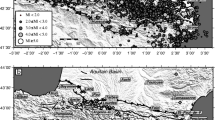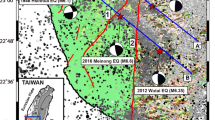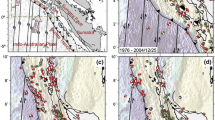Abstract
This study explores the spatial distribution of seismicity, the pattern of b-values, gravity and magnetic anomalies, heat flow data, and focal mechanism solutions to more thoroughly understand the present-day stress distribution and the nature of the crust, which characterize the rifting process in the northern Red Sea region. The region shows alternating low and high b-values in congruence with low and high cumulative seismic moment releases, respectively, and with negative and positive gravity anomalies, respectively. In general, except for larger-sized earthquake locations that characterized by high stress accumulation, low b-values, low seismic moment release, and low-gravity anomalies dominate the zones of the Gulf of Aqaba and the Gulf of Suez, thereby implying low stress accumulation consistent with an old crust of no differential development. Conversely, the rest of the Northern Red Sea region exhibited heterogeneities in the spatial distribution of b-values, cumulative seismic moment releases, and gravity anomalies, thereby implying stress heterogeneities. The stress heterogeneities may impute to the differences in material properties of the upper crust in the region. Zones of a positive Bouguer anomaly and high stress are notably associated with a relatively weak crust characterized by high rate of seismicity, while zones of the negative Bouguer anomaly and low stress characterized an older and more stable crust. However, details on the nature of crust required additional geophysical and geological data of high resolution in future studies.












Similar content being viewed by others
References
Abdelfattah AK, Almadani S, Fnais M, Alfaifi HJ, Al-Arifi N, Al-amri A et al (2019) Rupture characteristics of a small-sized earthquake (MW 4.2), onshore the south Red Sea, Saudi Arabia. J Afr Earth Sc 151:315–323
Abdel-Fattah AK, Mogren SM, Almadani S (2016) Seismicity constraints on stress regimes along Sinai subplate boundaries. Stud Geophys Geod 60(2):268–279
Aki K (1965) Maximum likelihood estimate of b in the formula log N = a-bM and its confidence limits. Bull Earthq Res Inst Tokyo Univ 43:237–239
Aki K (1966) Earthquake generating stress in Japan for the years 1961 to 1963 obtained by smoothing the first motion radiation patterns. Bull Earthq Res Inst Univ Tokyo 44:447–471
Al-Amri AM (1995) Recent seismic activity in the northern Red Sea. J Geodyn 20(3):243–253
Almalki KA, Betts PG, Ailleres L (2015) The Red Sea–50 years of geological and geophysical research. Earth Sci Rev 147:109–140
Almalki KA, Betts PG, Ailleres L (2016) Incipient seafloor spreading segments: insights from the Red Sea. Geophys Res Lett 43(6):2709–2715
ArRajehi A, McClusky S, Reilinger R, Daoud M, Alchalbi A, Ergintav S, Gomez F, Sholan J, Bou-Rabee F, Ogubazghi G, Haileab B (2010) Geodetic constraints on present-day motion of the Arabian Plate: implications for Red Sea and Gulf of Aden rifting. Tectonics 29(3):TC3011
Badawy A, Abdel-Fattah AK (2006) 2001 August earthquake swarm at Shadwan Island, Gulf of Suez, Egypt. Geophys J Int 167(1):288–296
Balmino G, Vales N, Bonvalot S, Briais A (2011) Spherical harmonic modeling to ultra-high degree of Bouguer and isostatic anomalies. J Geod 86:499–520
Ben-Menahem A, Aboodi E (1971) Tectonic patterns in the northern Red Sea region. J Geophys Res 76(11):2674–2689
Bentor YK (1985) The crustal evolution of the Arabo-Nubian Massif with special reference to the Sinai Peninsula. Precambr Res 28(1):1–74
Bonatti E (1985) Punctiform initiation of seafloor spreading in the Red Sea during transition from a continental to an oceanic rift. Nature 316(6023):33–37
Bonvalot S, Balmino G, Briais A, Kuhn M, Peyrefitte A, Vales N, Biancale R, Gabalda G, Reinquin F (2012) World Gravity Map: a set of global complete spherical Bouguer and isostatic anomaly maps and grids. In EGU general assembly conference abstracts 14:11091
Bosworth W (2015) Geological evolution of the Red Sea: historical background, review, and synthesis. In: Rasul NM, Stewart ICF (eds) The Red Sea. Springer, Berlin, pp 45–78
Bosworth W, Durocher S (2017) Present-day stress fields of the Gulf of Suez (Egypt) based on exploratory well data: non-uniform regional extension and its relation to inherited structures and local plate motion. J Afr Earth Sci 136:136–147
Bosworth W, Sultan M, Stern RJ, Arvidson RE, Shore P, Becker R (1993) Nature of the Red Sea crust: a controversy revisited: comment and reply. Geology 21(6):574–576
Bosworth W, Huchon P, McClay K (2005) The Red Sea and Gulf of Aden basins. J Afr Earth Sci 43(1–3):334–378
Bridges DL, Gao SS (2006) Spatial variation of seismic b-values beneath Makushin Volcano, Unalaska Island, Alaska. Earth Planet Sci Lett 245(1–2):408–415
Buck R, Martinez F, Steckler MS, Cochran JR (1988) Thermal consequences of lithospheric extension: pure and simple. Tectonics 7:213–234
Chang SJ, Van der Lee S (2011) Mantle plumes and associated flow beneath Arabia and East Africa. Earth Planet Sci Lett 302(3–4):448–454
Chernick MR (1999) Bootstrap methods: a practitioner’s guide, Wiley Series in Probability and Statistics. Wiley-Interscience Publication, London
Chu D, Gordon RG (1998) Current plate motions across the Red Sea. Geophys J Int 135:313–328
Cochran JR (1983) A model for development of Red Sea. Aapg Bull 67(1):41–69
Cochran JR (2005) Northern Red Sea: nucleation of an oceanic spreading center within a continental rift. Geochem Geophys Geosyst 6(3):34
Cochran JR, Karner GD (2007) Constraints on the deformation and rupturing of continental lithosphere of the Red Sea: the transition from rifting to drifting. Geol Soc Lond Special Publ 282(1):265–289
Cochran JR, Martinez F (1988) Evidence from the northern Red Sea on the transition from continental to oceanic rifting. Tectonophysics 153(1–4):25–53
Daradich A, Mitrovica JX, Pysklywec RN, Willett SD, Forte AM (2003) Mantle flow, dynamic topography, and rift-flank uplift of Arabia. Geology 31(10):901–904
Davies JH (2013) Global map of solid Earth surface heat flow. Geochem Geophys Geosyst 14(10):4608–4622
Dyment J, Tapponnier P, Afifi AM, Zinger MA, Franken D, Muzaiyen E (2013) A new seafloor spreading model of the Red Sea: magnetic anomalies and plate kinematics. American Geophysical Union, Fall Meeting, abstract #T21A-2512
Edrik M, Kamer Y, Demircioğlu M, Şeşetyan K (2012) 23 October 2011 Van (Turkey) earthquake. Nat Hazards 64:651–665
Ehrhardt A, Hübscher C (2015) The northern Red Sea in transition from rifting to drifting-lessons learned from ocean deeps. In: Rasul NM, Stewart ICF (eds) The Red Sea. Springer, Berlin, pp 99–121
El-Isa Z, Shanti A (1989) Seismicity and tectonics of the Red Sea and western Arabia. Geophys J Int 97(3):449–457
El Khrepy S, Koulakov I, Al-Arifi N (2016a) Crustal and uppermost mantle structure beneath the continental rifting area of the Gulf of Suez from earthquake tomography. Tectonophysics 668:92–104
El Khrepy S, Koulakov I, Al-Arif N, Petrunin AG (2016b) Seismic structure beneath the Gulf of Aqaba and adjacent areas based on the tomographic inversion of regional earthquake data. Universitätsbibliothek Johann Christian Senckenberg, Frankfurt am Main
El-Bohoty M, Brimich L, Saleh A, Saleh S (2012) Comparative study between the structural and tectonic situation of the Southern Sinai and the Red Sea, Egypt, as deduced from magnetic, gravity and seismic data. Contrib Geophys Geod 42(4):357–388
El-Nader IA, Hussein HM (2018) The present-day active deformation in the central and northern parts of the Gulf of Suez area, Egypt, from earthquake focal mechanism data. Nat Hazards 92(3):1355–1369
Freund R, Garfunkel Z, Zak I, Goldberg M, Weissbrod T, Derin B, Bender F, Wellings FE, Girdler RW (1970) The shear along the Dead Sea rift. Philos Trans R Soc Lond Ser A Math Phys Sci 267:107–130
Garson MS, Krs M (1976) Geophysical and geological evidence of the relationship of Red Sea transverse tectonics to ancient fractures. Geol Soc Am Bull 87(2):169–181
Gaulier JM, Le Pichon X, Lyberis N, Avedik F, Geli L, Moretti I, Deschamps A, Hafez S (1988) Seismic study of the crust of the northern Red Sea and Gulf of Suez. Tectonophysics 153(1–4):55–88
Ghebreab W (1998) Tectonics of the Red Sea region reassessed. Earth Sci Rev 45(1–2):1–44
Girdler RW, Underwood M (1985) The evolution of early oceanic lithosphere in the southern Red Sea. Tectonophysics 116(1–2):95–108
Gomez F, Nemer T, Tabet C, Khawlie M, Meghraoui M, Barazangi M (2007) Strain partitioning of active transpression within the Lebanese restraining bend of the Dead Sea Fault (Lebanon and SW Syria). Geol Soc Lond Spec Publ 290(1):285–303
Görgün E (2013) Analysis of the b-values before and after the 23 October 2011 Mw 7.2 Van-Erciş, Turkey earthquake. Tectonophysics 603:213–221
Guennoc P, Pautot G, Coutelle A (1988) Surficial structures of the northern Red Sea axial valley from 23 N to 28 N: time and space evolution of neo-oceanic structures. Tectonophysics 153(1–4):1–23
Gutenberg B, Richter CF (1941) Seismicity of the Earth. Geol Soc Am Sp Pap 34:1–133
Joffe S, Garfunkel Z (1987) Plate kinematics of the circum Red Sea—a re-evaluation. Tectonophysics 141(1–3):5–22
Kalyoncuoglu UY, Elitok Ö, Dolmaz MN (2013) Tectonic implications of spatial variation of b-values and heat flow in the Aegean region. Mar Geophys Res 34(1):59–78
Kalyoncuoğlu ÜY, Elitok Ö, Dolmaz MN, Anadolu NC (2011) Geophysical and geological imprints of southern Neotethyan subduction between Cyprus and the Isparta Angle, SW Turkey. J Geodyn 52(1):70–82
Kanamori H, Brodsky EE (2001) The physics of earthquakes. Phys Today 54(6):34–40
Khan PK (2005) Mapping of b-value beneath the Shillong Plateau. Gondwana Res 8(2):271–276
Khan PK, Chakraborty PP (2007) The seismic b-value and its correlation with Bouguer gravity anomaly over the Shillong Plateau area: tectonic implications. J Asian Earth Sci 29(1):136–147
LaBrecque JL, Zitellini N (1985) Continuous sea-floor spreading in Red Sea: an alternative interpretation of magnetic anomaly pattern. AAPG Bull 69(4):513–524
Lei X (2003) How do asperities fracture? An experimental study of unbroken asperities. Earth Planet Sci Lett 213(3–4):347–359
Ligi M, Bonatti E, Bosworth W, Cai Y, Cipriani A, Palmiotto C, Ronca S, Seyler M (2018) Birth of an ocean in the Red Sea: oceanic-type basaltic melt intrusions precede continental rupture. Gondwana Res 54:150–160
Lolli B, Gasperini P, Vannucci G (2014) Empirical conversion between teleseismic magnitudes (mb and Ms) and moment magnitude (Mw) at the Global, Euro-Mediterranean and Italian scale. Geophys J Int 199(2):805–828
Lucazeau F (2019) Analysis and mapping of an updated terrestrial heat flow data set. Geochem Geophys Geosyst 20(8):4001–4024
Maden N, Öztürk S (2015) Seismic b-values, bouguer gravity and heat flow data beneath Eastern Anatolia, Turkey: tectonic implications. Surv Geophys 36(4):549–570
Mahmoud S, Reilinger R, McClusky S, Vernant P, Tealeb A (2005) GPS evidence for northward motion of the Sinai Block: implications for E. Mediterranean tectonics. Earth Planet Sci Lett 238(1–2):217–224
Mart Y, Hall JK (1984) Structural trends in the northern Red Sea. J Geophys Res Solid Earth 89(B13):11352–11364
Mart Y, Horowitz A (1981) The tectonics of the Timna region in southern Israel and the evolution of the Dead Sea Rift. Tectonophysics 79(3–4):165–199
Mart Y, Rabinowitz PD (1986) The northern red sea and the dead sea rift. Tectonophysics 124(1–2):85–113
McNutt SR (2005) Volcanic seismology. Annu Rev Earth Planet Sci 32:461–491
Meyer B, Saltus R, Chulliat A (2017) EMAG2: earth magnetic anomaly grid (2-arc-minute resolution) version 3. National Centers for Environmental Information, NOAA, Model, Asheville
Mitchell NC, Park Y (2014) Nature of crust in the central Red Sea. Tectonophysics 628:123–139
Mitchell NC, Stewart IC (2018) The modest seismicity of the northern Red Sea rift. Geophys J Int 214(3):1507–1523
Mogi K (1963) Some discussions on aftershocks, foreshocks, and earthquake swarms—the fracture of a semi-infinite body caused by an inner stress origin and its relation to the earthquake phenomena. 3. Bull Earthquake Res Inst Tokyo 41:615–658
Mogi K (1967) Effect of the intermediate principal stress on rock failure. J Geophys Res 72(20):5117–5131
Mousavi SM (2017a) Mapping seismic moment and b-value within the continental collision orogenic-belt region of the Iranian Plateau. J Geodyn 103:26–41
Mousavi SM (2017b) Spatial variation in the frequency–magnitude distribution of earthquakes under the tectonic framework in the Middle East. J Asian Earth Sci 147:193–209
Pamukçu O (2016) Geodynamic assessment of Eastern Mediterranean region: a joint gravity and seismic b value approach. Arab J Geosci 9(5):360
Pavlis NK, Holmes SA, Kenyon SC, Factor JK (2012) The development and evaluation of the Earth Gravitational Model 2008 (EGM2008). J Geophys Res Solid Earth 117(B4):B04406
Rihm R, Makris J, Möller L (1991) Seismic surveys in the Northern Red Sea: asymmetric crustal structure. Tectonophysics 198(2–4):279–295
Saleh S, Salk M, Pamukçu O (2013) Estimating Curie point depth and heat flow map for northern Red Sea rift of Egypt and its surroundings, from aeromagnetic data. Pure Appl Geophys 170(5):863–885
Sánchez JJ, McNutt SR, Power JA, Wyss M (2004) Spatial variations in the frequency–magnitude distribution of earthquakes at Mount Pinatubo Volcano. Bull Seismol Soc Am 94(2):430–438
Sandwell D, Garcia E, Soofi K, Wessel P, Chandler M, Smith WH (2013) Toward 1-mGal accuracy in global marine gravity from CryoSat-2, Envisat, and Jason-1. Lead Edge 32(8):892–899
Sandwell DT, Müller RD, Smith WH, Garcia E, Francis R (2014) New global marine gravity model from CryoSat-2 and Jason-1 reveals buried tectonic structure. Science 346(6205):65–67
Scholz CH (1968) Experimental study of the fracturing process in brittle rock. J Geophys Res 73(4):1447–1454
Schorlemmer D, Wiemer S, Wyss M (2004) Earthquake statistics at Parkfield: 1 Stationarity of b values. J Geophys Res Solid Earth 109(B12):B12308
Schorlemmer D, Wiemer S, Wyss M (2005) Variations in earthquake-size distribution across different stress regimes. Nature 437(7058):539–542
Shi Y, Bolt BA (1982) The standard error of the magnitude-frequency b value. Bull Seismol Soc Am 72(5):1677–1687
Sobiesiak M, Meyer U, Schmidt S, Götze HJ, Krawczyk CM (2007) Asperity generating upper crustal sources revealed by b value and isostatic residual anomaly grids in the area of Antofagasta, Chile. J Geophys Res Solid Earth 112(B12):B12308
Stein M, Goldstein SL (1996) From plume head to continental lithosphere in the Arabian-Nubian shield. Nature 382(6594):773–778
Stern RJ (1994) Neoproterozoic (900–550 Ma) arc assembly and continental collision in the East African Orogen. Ann Rev Earth Planet Sci 22:319–351
Stern RJ, Johnson P (2010) Continental lithosphere of the Arabian Plate: a geologic, petrologic, and geophysical synthesis. Earth Sci Rev 101(1–2):29–67
Stern RJ, Johnson PR (2019) Constraining the opening of the Red Sea: evidence from the neoproterozoic margins and cenozoic magmatism for a volcanic rifted margin. In: Rasul NM, Stewart ICF (eds) Geological setting, palaeoenvironment and archaeology of the Red Sea. Springer, Cham, pp 53–79
Sultan M, Becker R, Arvidson RE, Shore P, Stern RJ, El Alfy Z, Guinness EA (1992) Nature of the Red Sea crust: a controversy revisited. Geology 20(7):593–596
Tapponnier P, Dyment J, Zinger MA, Franken D, Afifi AM, Wylie A, Ali HG, Hanbal I (2013) Revisiting seafloor-spreading in the Red Sea: basement nature, transforms and ocean-continent boundary, American Geophysical Union, Fall Meeting 2013, San Francisco, CA, 9–13 Dec, abstract #T12B-04
Urbancic TI, Trifu CI, Long JM, Young RP (1992) Space-time correlations of b values with stress release. Pure Appl Geophys 139(3–4):449–462
Wang JH (1988) b values of shallow earthquakes in Taiwan. Bull Seismol Soc Am 78(3):1243–1254
Warren NW, Latham GV (1970) An experimental study of thermally induced microfracturing and its relation to volcanic seismicity. J Geophys Res 75(23):4455–4464
Wdowinski S, Bock Y, Baer G, Prawirodirdjo L, Bechor N, Naaman S, Knafo R, Forrai Y, Melzer Y (2004) GPS measurements of current crustal movements along the Dead Sea Fault. J Geophys Res Solid Earth 109(B5):B05403
Wessel P, Smith WHF (1995) New version of the generic mapping tools released. Eos Trans Am Geophys Uninon 76:329
Wiemer S, Zuňiga FR (1994) ZMAP - A software package to analyze seismicity. EOS, Trans., Fall Meeting. 75. AGU, p. 456
Wiemer S, Katsumata K (1999) Spatial variability of seismicity parameters in aftershock zones. J Geophys Res Solid Earth 104(B6):13135–13151
Wiemer S, Wyss M (2000) Minimum magnitude of completeness in earthquake catalogs: examples from Alaska, the western US and Japan. Bull Seism Soc Am 90:859–869
Wiemer S, McNutt SR, Wyss M (1998) Temporal and three-dimensional spatial analyses of the frequency-magnitude distribution near Long Valley Caldera, California. Geophys J Int 134:409–421
Wyss M (1973) Towards a physical understanding of the earthquake frequency distribution. Geophys J R Astron Soc 31(4):341–359
Wyss M, Stefansson R (2006) Nucleation points of recent mainshocks in southern Iceland, mapped by b-values. Bull Seismol Soc Am 96(2):599–608
Acknowledgements
The authors extend their sincere appreciation to the Deanship of Scientific Research at King Saud University for funding this work through research Group No. RG-1441-320. Generic Mapping Tools developed by Wessel and Smith (1995) were used for most data mapping.
Author information
Authors and Affiliations
Corresponding author
Ethics declarations
Conflict of interest
The authors declare no potential conflict or competing interests.
Additional information
Publisher's Note
Springer Nature remains neutral with regard to jurisdictional claims in published maps and institutional affiliations.
Rights and permissions
About this article
Cite this article
Abdelfattah, A.K., Jallouli, C., Qaysi, S. et al. Crustal Stress in the Northern Red Sea Region as Inferred from Seismic b-values, Seismic Moment Release, Focal Mechanisms, Gravity, Magnetic, and Heat Flow Data. Surv Geophys 41, 963–986 (2020). https://doi.org/10.1007/s10712-020-09602-8
Received:
Accepted:
Published:
Issue Date:
DOI: https://doi.org/10.1007/s10712-020-09602-8




